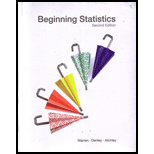
(a)
To find:
Find the
Answer to Problem 9E
Solution:
The probability of a random person on the street having an IQ score of less than 95 is 0.3707.
Explanation of Solution
Given:
Given a population of size
On dealing with the collection of these means for samples chosen from the population, the concept of sampling distribution pops and the statistic dealt with is the sample means, and that the distribution contains all possible samples for the chosen sample size.
The continuity criterion can be extended and here it is known as Central Limit Theorem which states that sampling distribution is approximately normal with:
a. mean
b. Standard deviation
Moreover, the standard score is given by:
Thereafter, the required probability is accordingly obtained by taking into account the specifics in the question.
Calculation:
The value of the standard score (z-score)
Now probability of x less than 95 is calculated as
So, the probability of a random person on the street having an IQ score of less than 95 is 0.3707.
(b)
To find:
Find the probability that the mean of the sample taken is less than 95.
Answer to Problem 9E
Solution:
The probability that the mean of the sample taken is less than 95 is 0.0091.
Explanation of Solution
Calculation:
The value of the standard score (z-score)
The probability using z table is calculated as:
So the probability that the mean of the sample taken is less than 95 is 0.0091.
(c)
To find:
Find the probability that the mean of the sample taken will be more than 95.
Answer to Problem 9E
Solution:
The probability that the mean of the sample taken will be more than 95 is 0.9909.
Explanation of Solution
Calculation:
The value of the standard score (z-score)
The probability using z table is calculated as:
The probability that the mean of the sample taken will be more than 95 is 0.9909.
(d)
To find:
Find the probability that the mean of the sample taken will be more than 105.
Answer to Problem 9E
Solution:
The probability that the mean of the sample taken will be more than 105 is 0.0091.
Explanation of Solution
Calculation:
The value of the standard score (z-score)
The probability using z table is calculated as:
The probability that the mean of the sample taken will be more than 105 is 0.0091.
(e)
To find:
Find the probability that the sample mean differs from the population mean by more than 5.
Answer to Problem 9E
Solution:
The probability that the sample mean differs from the population mean by more than 5 is 0.0182.
Explanation of Solution
Calculation:
The probability that the sample mean differs from the population mean by more than 5 is calculated as:
The probability using z table is calculated as:
Want to see more full solutions like this?
Chapter 7 Solutions
Beginning Statistics, 2nd Edition
- A marketing agency wants to determine whether different advertising platforms generate significantly different levels of customer engagement. The agency measures the average number of daily clicks on ads for three platforms: Social Media, Search Engines, and Email Campaigns. The agency collects data on daily clicks for each platform over a 10-day period and wants to test whether there is a statistically significant difference in the mean number of daily clicks among these platforms. Conduct ANOVA test. You can provide your answer by inserting a text box and the answer must include: also please provide a step by on getting the answers in excel Null hypothesis, Alternative hypothesis, Show answer (output table/summary table), and Conclusion based on the P value.arrow_forwardA company found that the daily sales revenue of its flagship product follows a normal distribution with a mean of $4500 and a standard deviation of $450. The company defines a "high-sales day" that is, any day with sales exceeding $4800. please provide a step by step on how to get the answers Q: What percentage of days can the company expect to have "high-sales days" or sales greater than $4800? Q: What is the sales revenue threshold for the bottom 10% of days? (please note that 10% refers to the probability/area under bell curve towards the lower tail of bell curve) Provide answers in the yellow cellsarrow_forwardBusiness Discussarrow_forward
- The following data represent total ventilation measured in liters of air per minute per square meter of body area for two independent (and randomly chosen) samples. Analyze these data using the appropriate non-parametric hypothesis testarrow_forwardeach column represents before & after measurements on the same individual. Analyze with the appropriate non-parametric hypothesis test for a paired design.arrow_forwardShould you be confident in applying your regression equation to estimate the heart rate of a python at 35°C? Why or why not?arrow_forward
 MATLAB: An Introduction with ApplicationsStatisticsISBN:9781119256830Author:Amos GilatPublisher:John Wiley & Sons Inc
MATLAB: An Introduction with ApplicationsStatisticsISBN:9781119256830Author:Amos GilatPublisher:John Wiley & Sons Inc Probability and Statistics for Engineering and th...StatisticsISBN:9781305251809Author:Jay L. DevorePublisher:Cengage Learning
Probability and Statistics for Engineering and th...StatisticsISBN:9781305251809Author:Jay L. DevorePublisher:Cengage Learning Statistics for The Behavioral Sciences (MindTap C...StatisticsISBN:9781305504912Author:Frederick J Gravetter, Larry B. WallnauPublisher:Cengage Learning
Statistics for The Behavioral Sciences (MindTap C...StatisticsISBN:9781305504912Author:Frederick J Gravetter, Larry B. WallnauPublisher:Cengage Learning Elementary Statistics: Picturing the World (7th E...StatisticsISBN:9780134683416Author:Ron Larson, Betsy FarberPublisher:PEARSON
Elementary Statistics: Picturing the World (7th E...StatisticsISBN:9780134683416Author:Ron Larson, Betsy FarberPublisher:PEARSON The Basic Practice of StatisticsStatisticsISBN:9781319042578Author:David S. Moore, William I. Notz, Michael A. FlignerPublisher:W. H. Freeman
The Basic Practice of StatisticsStatisticsISBN:9781319042578Author:David S. Moore, William I. Notz, Michael A. FlignerPublisher:W. H. Freeman Introduction to the Practice of StatisticsStatisticsISBN:9781319013387Author:David S. Moore, George P. McCabe, Bruce A. CraigPublisher:W. H. Freeman
Introduction to the Practice of StatisticsStatisticsISBN:9781319013387Author:David S. Moore, George P. McCabe, Bruce A. CraigPublisher:W. H. Freeman





